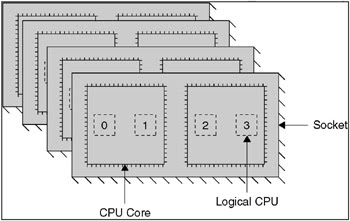
A thread is a unit of execution that runs on a CPU that can only execute one thread at a time. However, a CPU is very good at switching between threads very quickly to share its power, giving the illusion of simultaneous execution.
Hyper-Threading is a technology found only on Intel processors, that tries to make more efficient use of the CPU by duplicating the architectural state to provide two logical CPUs.
This allows more than 1 thread to be scheduled and enables simultaneous execution when the threads require different processor functions. The effect of this is that you will see two logical CPUs to which the operating system can assign different threads. However, it is only the architectural state that is duplicated, not the physical execution engine. Figure shows a 4 dual-core system with Hyper-Threading enabled, giving 16 logical processors.
Hyper-Threading is only ever going to give you a maximum of 1.3 times nonHyper-Threaded performance and in practice it will be closer to 1.1 to 1.15 times. This knowledge helps put any decision about enabling it back into perspective.
Disable Hyper-Threading unless you have the time to test it thoroughly. Don’t use it on Windows 2000 as it’s not Hyper-Threading aware.
No comments:
Post a Comment